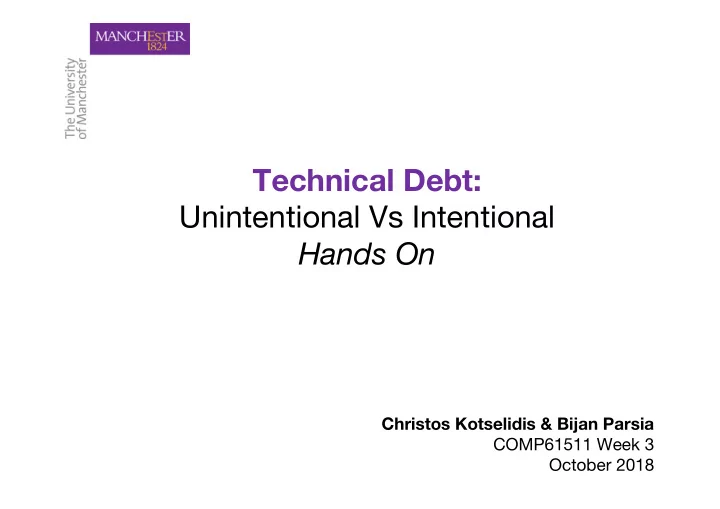

Technical Debt: Unintentional Vs Intentional Hands On Christos Kotselidis & Bijan Parsia COMP61511 Week 3 October 2018
Technical Debt • Results from every day decisions we make • Should I hack it? Should I push it? • “There is always time for later corrections” • … after all is just software … right? 2
Real-world use cases • Unintentional Debt – Example 1: Push, push, push… • Intentional Debt – Example 2: …don’t worry, we will fix it later… 3
Example 1: Push, Push, Push … 1. Code 2. Commit • Very structural 3. Pull Request • Protection against “unintentional debt” 4. Gate • … but does it?? 5. Code Review 6. Merge (Push) 7. Regress 4
Example 1: Push, Push, Push … 5
Example 1: Push, Push, Push … 1. Code 2. Commit 3. Pull Request 4. Gate 5. Code Review 6. Merge (Push) 7. Regress 6
Example 1: Push, Push, Push … 15% Electricity Increase WAT?!?!?!?! 7
Example 1: Push, Push, Push … 1. 13 pushes 2. 1 Regression per push 3. Oh no … . 8
Example 1: Push, Push, Push … Debt calculation (1/3) • 1200 Watt regression machine • 8 hours per regression • 13 regressions (+1 after fix) = 14 Electricity Cost = KWhs * Price = 134,4 * 0.12 = 16 GBP (+tax|fees) = 18-20 GBP 9
Example 1: Push, Push, Push … Debt calculation (2/3) • Training Costs • 2 persons (trainer + trainee) • 1 hour training * 2 = 2 hours Training Cost = PHs * Price = 2 * 50 = 100 GBP (+insurance, etc.) = 170 GBP 10
Example 1: Push, Push, Push … Debt calculation (3/3) Total Cost = Training Cost * Electricity Cost = 190 GBP • Excluding delay release costs • … and other indirect costs … 11
Example 1: Push, Push, Push … Solution • Assess regression testing • Understand trade-o ff s – Coverage vs operational costs • Design new Continuous Integration (CI) Framework 12
Example 1: Push, Push, Push … Solution 13
Example 1: Push, Push, Push … Conclusions • Simple SW malpractices can lead to: – Unintended Debt – Delays – Increased Operational Costs • Solution? – Compulsory pre-push code reviews – More training on how to use tools – Hooks to check per user frequent pushes 14
Example 2: … don’t worry, we will fix it later … • Disclaimer : I take full responsibility for that 15
Example 2: … don’t worry, we will fix it later … A method that compiles a function for a specific architecture (ARM) • 16
Example 2: … don’t worry, we will fix it later … Inconsistent comment : not any ARM, just ARMv7 • Hardcoded constants | flags | etc. : e.g. “arm-none-eabi-gcc” • Wrong class name: MaxineARMTester à What if we want to implement • ARMv8? … don’t worry, we will fix later … • 17
Example 2: Past and Future • First commit (April 2014): • Fast Forward to October 2017: – Hey! Let’s do the ARMv8 Port! – All the infrastructure is ready! – We just plug in the ARMv8 tools to MaxineTester – Maximum a 2 hours job! – YEAH! LET’S DO IT!!!!! 18
Example 2: Intentional Debt Ghosting • “Ooops! Sorry team, I forgot … ” – “back then, I hardcoded everything” – “also the class is not properly designed, so now we have to split in two” – “oh, we also need to refactor all ARMv7 tests to use new class!” – “oh no!!! We also need to create two separate paths of execution!” – “ … oh … .oh … oh” 19
Example 2: Intentional Debt Ghosting 20
Lessons Learned • Example 1: push, push, push … – Unintentional debt can appear even if everything looks OK! – Increased Operational Costs – Attention to details!!! • Example 2: “ … don’t worry we will fix it later … ” – Intentional debt underestimated – Kept lurking in the code for 3 years! – And finally got its revenge – Attention to debt assessment!!! 21
Conclusions • Debt no matter if intentional or unintentional – Is usually there – It creates costs: money, work e ff ort, etc. • Aim for quality code – Always justify your intentional debt – Risk assessment is critical 22
Recommend
More recommend